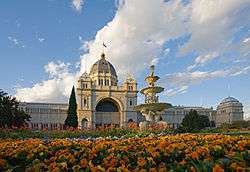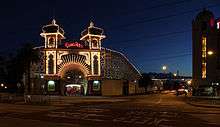Tourism in Melbourne

Tourism in Melbourne is a significant industry in the Australian state of Victoria. Melbourne, the country's second most-populous city, was visited by just under two million international overnight visitors and 57.7 million domestic overnight visitors during the year ending March 2014.[1] Melbourne's attractions include spectator sports, art, live music, festivals and fashion events that are popular with tourists. In 2008 Melbourne exceeded Sydney for the first time, in terms of money spent by domestic tourists on a per capita basis; however, at the time that the figures were released, a spokesman for the NSW Tourism Minister stated that Melbourne earned less in terms of overall tourist revenue.[2]
In its annual survey of readers, the Conde Nast Traveler magazine found that both Melbourne, Australia and Auckland, New Zealand were considered the world's friendliest cities in 2014. Both cities received scores of "86.0", while the magazine describes the "wonderful sense of humour" of Melburnians, who live among public art and parks.[3][4]
Popular sites and events
Melbourne has numerous year-round events and attractions, such as:
.jpg)
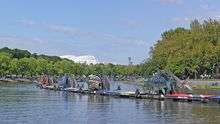
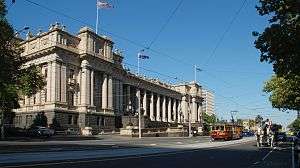
- Federation Square is a major meeting place in Melbourne. It is close to Flinders Street Station, the Melbourne Cricket Ground (MCG), and various other sporting and cultural venues. The square includes several buildings, housing the National Gallery of Victoria (NGV) and the Australian Centre for the Moving Image (ACMI), as well as exhibition spaces, auditoriums, restaurants, bars and shops. Cultural and various sporting events, including concerts, are staged in the Square,[5][6] and the Square's large electronic screen is also used.[7] The Melbourne Visitor Centre, the city's main tourist information office, is located at Federation Square, opposite Flinders Street railway station, Australia's oldest train station.[8][9]
- Birrarung Marr, a park on the banks of the Yarra River, is adjacent to Federation Square. The 2006 FIFA World Cup was broadcast for free public consumption at this location.[10]
- The Melbourne Cricket Ground—known as "the MCG", or simply the "G"—is a sporting stadium with the largest capacity in Australia. The MCG was the centrepiece stadium of the 1956 Summer Olympic Games, and the renovations in preparation for the 2006 Commonwealth Games increased the stadium's capacity to 103,000. From April to September, the stadium typically hosts one or two Australian rules football matches each week. It has also hosted two Bledisloe Cup rugby matches. During the summer, international cricket matches, such as the Boxing Day Test and several one-day internationals (ODIs), are played at the MCG.
- The Old Melbourne Gaol - When the Old Melbourne Gaol was built in the mid-1800s, it dominated the Melbourne skyline as a symbol of authority. Inside the Gaol, dangerous criminals were held alongside petty offenders, the homeless and the mentally ill. Between 1842 and its closure in 1929 the gaol was the scene of 133 hangings including Australia’s most infamous citizen, the bushranger Ned Kelly. Today you can visit the Old Melbourne Gaol to find out was life was like for the men and women who lived and died here all those years ago.
- Eureka Skydeck, is the highest viewing platform in the southern hemisphere and is located in Eureka Tower. The observation deck includes a glass cube ride that projects three meters from the side of the building.
- Melbourne Park is the home of the Australian Open tennis tournament. Held every January, it is one of the four Grand Slam tournaments.
- The Melbourne Exhibition and Convention Centre is located in Southbank and was built in the 1990s as a replacement for the Royal Exhibition Building. It has hosted conventions and exhibitions since its opening.
- The Melbourne Museum is located on the north-eastern fringe of the CBD, next to the Royal Exhibition Building. To many Melburnians, the most significant exhibit is the preserved body of Phar Lap, a famous racehorse of the Depression era. The Forest Gallery is a living internal facsimile replicating the forests of the nearby Dandenong Ranges. CSIRAC, the fifth electronic computer built and the only one of its generation to survive intact is also on display. The museum complex is also home to Melbourne's IMAX cinema.
- The Royal Exhibition Building located in the Carlton Gardens was built in the 1880s for the World's Fair and is only one of a few such buildings that still exist. The building and gardens were granted World Heritage listing on 2 July 2004. It is the first building in Australia to be granted this status. The building also held the first sitting of the Australian Parliament on 9 May 1901. Subsequent federal parliamentary sittings were then moved to the Victorian Parliament building located in Spring Street and the Victorian government moved to the Exhibition Building.
- The State Library of Victoria is on Swanston Street, with its large Domed Reading Room and statue-filled front lawn.
- The National Gallery of Victoria possesses the largest art collection in Australia. The gallery operates from two sites: one housing the Australian collection at the Ian Potter Centre: NGV Australia at Federation Square (notably featuring key works from the Heidelberg School); and the NGV International collection housed in the main St Kilda Road building.
- The Victorian Arts Centre at Southgate is a Melbourne landmark with its enormous skyward spire. It hosts Opera Australia's Melbourne season, the Melbourne Symphony Orchestra, the Melbourne Theatre Company, the Australian Ballet Company, Chunky Move (one of Australia's best-known contemporary dance companies), and other touring productions. The centre consists of two separate buildings: the State Theatre; and Hamer Hall (this was recently renamed in honour of the late former premier Sir Rupert Hamer. The acoustics of the Centre are often favourably compared with those of its interstate rival, the opera theatre in the Sydney Opera House.
- Crown Casino on the Yarra River is the largest gambling centre in the southern hemisphere. The Crown Entertainment Complex also encompasses one of Melbourne's best hotels the Crown Towers, restaurants, boutiques and cinemas. Crown also has the Palladium Ballroom which hosts some of Melbourne's biggest events, such as the Logies and the Brownlow Medal AFL award.
- The Melbourne Aquarium contains a variety of exhibits showcasing marine wildlife found in the Southern Ocean and the Antarctic.
- The Shrine of Remembrance on St Kilda Road is one of Australia's largest war memorials. It is the site of annual observances of ANZAC Day and Remembrance Day.
- Docklands is Melbourne's newest precinct and largest infrastructure development to date, and is also becoming a major tourist attraction. The Docklands area opens up the waterfront to the CBD, and is projected to attract millions of visitors every year. Telstra Dome, the Melbourne Star Ferris wheel, GlowGolf, public art displays and several dining precincts can be found in Docklands.
- Luna Park Melbourne is an amusement park located on the foreshore of Port Phillip Bay in St Kilda, an inner suburb of Melbourne. It has been operating since 1912.
- Love lock Bridge at Southgate, Melbourne is yet another architectural masterpiece and symbol of love. Located right in the heart of the Melbourne city, the footbridge that crosses the Yarra river has thousands of padlocks attached to the sides. Situated close to the iconic Flinders Street Station, it is a popular and unique way of showing your love for someone by attaching a lock and throwing the key into the river. Over the past 10 years the huge number of locks and the lovely gesture has made this a popular visitor destination.
Restaurants


Melbourne is also noted for the number, variety and quality of its restaurants. Major restaurant strips are found throughout the city and the suburbs, including:
- Chinatown, on Little Bourke Street and now spreading out onto Russell Street in the CBD, offers numerous restaurants, mainly but not exclusively offering Cantonese cuisine, at the lower end offering Hong Kong-style noodle restaurants up to the Flower Drum, renowned for its Peking duck and is generally regarded as one of Melbourne's best restaurants.
- Lygon Street, in the inner-northern suburb of Carlton, offers a selection of mainly Italian-influenced food.
- Brunswick Street in inner-suburban Fitzroy used to be a bohemian community of students, artists, and poets, and it still retains some remnants its bohemian past with the presence of several live music venues, all manner of eclectic stores, accompanied by restaurants and cafes, many of which serve varied and contemporary menus.
- Chapel Street, south of the city is a popular destination for fashionable clothes shopping, eating and entertainment. The long street contains commercial areas providing goods and services for local residents. Chapel Street intersects with Toorak Road, itself offering entertainment, food and shops.
- Glenferrie Road, east of the city in inner suburban Malvern has a wide mix of different cuisines including Indian, Malaysian, Thai and Japanese. The street intersects with High Street in Armadale which also has a mix of antique shops, cafes and restaurants.
- Glenhuntly Road, south east of the city in inner suburban Elsternwick is a busy strip that offers a wide range of different restaurant cuisines including Chinese, Malaysian Indian, Thai, and some Middle Eastern cuisines.
- Nelson Place faces the water in Williamstown, and is especially popular for lazy weekend breakfasts and lunches. There are restaurants and cafes featuring the usual range of cuisines, and footpath tables outside many of the establishments.
Cafes and nightlife

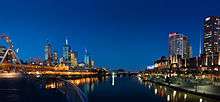
Melbourne contains all manner of pubs, bars, and nightclubs. The CBD contains a wide variety of venues, from the ubiquitous faux-Irish pubs and more traditional Australian hotels, through some very upmarket wine bars, serious jazz venues on Bennetts Lane, fashionable nightclubs and dance venues (where the Melbourne Shuffle was born), are often hidden away down dark alleyways.
The restaurant strips, particularly Brunswick Street have their own bars, some of which are the best rock venues in Melbourne. King Street, on the southern side of the CBD, was traditionally a nightclub strip and still hosts several, but many are now exotic dancing venues. Chapel Street, Prahran, is perhaps the trendiest, most upmarket nightlife strip. Bayside St Kilda is the home of several huge music venues including the famous Esplanade Hotel (known as 'the Espy'), the Prince of Wales, and The Palace.
The recent influx of city-dwellers has given rise to the numerous underground bars and sidewalk cafes in the alleys between Flinders Street – Flinders Lane and Bourke Street – Lonsdale Street. Notable alleys include Block Arcade/Block Place, Degraves Street, and Hardware Lane.
Other prominent café strips include:
- St Kilda's Fitzroy Street, Carlisle Street and Acland Street are home to many popular cafes.
- Fitzroy's Brunswick Street
- South Yarra's Chapel Street
- Collingwood's Smith Street
- Richmond's Bridge Road
- Southbank's Southgate and Crown Casino.
Melbourne also has a vibrant gay community, with gay and gay-friendly bars across the city. It is mostly concentrated on two gay villages – Commercial Rd, South Yarra and Smith St, Collingwood, but there are also gay bars and clubs in St Kilda, Fitzroy, Richmond and Yarraville.
Close to Melbourne
There are a variety of interesting things to see outside Melbourne proper but still within a day trip of Melbourne:
- The Yarra Valley region, producer of high-quality wine and with rainforest scenery nearby.
- The Mornington Peninsula, with its wineries, beaches and the Arthurs Seat lookout.
- The Surf Coast near Geelong, with its surf beaches and views of the Great Ocean Road (Voted the world's best road trip in 2003).
- Ballarat, a small city once the centre of the gold rush and site of the Eureka Stockade.
- Bendigo.
- Phillip Island, home of the Australian Motorcycle Grand Prix, also has one of the few easily accessible colonies of little penguins.
- French Island in Western Port Bay
- Geelong, 80 kilometres (50 mi) down the Princes Hwy is the gateway to many of Australia's tourist destinations such as the Great Ocean Road, Twelve Apostles and Bells Beach. Geelong is famous for its world class waterfront on Corio Bay. One of the largest waterfront redevelopments ever undertaken in Australia, Waterfront Geelong includes Cunningham Pier featuring a Carousel Pavilion, and the art-deco bathing area at Eastern Beach.
- Gippsland region, home of the Gourmet Deli Tours, the Gippsland Lakes, Wilsons Promontory (with South Point, the most southerly point of the Australian mainland), and many picturesque towns such as Sale, Foster, Bairnsdale, Lakes Entrance, and Warragul – one of the richest dairy farming areas in Australia. The ghost town of Walhalla is filled with goldmining memorabilia.
- Dandenong Ranges are famous for the Puffing Billy steam train in Belgrave, a large suburb of Melbourne, the Dandenong Ranges are located less than 30 kilometres (19 mi) from Melbourne with the townships of Mount Dandenong, Olinda, Upwey, Sassafrass and the commercial, residential and large "capitals", Belgrave and Ferntree Gully, the Dandenongs are also known for the view of the sun setting over Melbourne.

See also
- Culture of Melbourne
- History of Melbourne
- List of museums in Melbourne
- Media in Melbourne
- Transport in Melbourne
- Tourism in Australia

References
- ↑ "International visitation". Tourism Victoria Corporate Website. State Government of Victoria, Australia. March 2014. Retrieved 21 August 2014.
- ↑ Annabel Stafford (19 May 2008). "Now Sydney loses its tourism ascendancy". The Age. Retrieved 21 August 2014.
- ↑ Kylie McLaughlin (18 August 2014). "Melbourne named the world's friendliest city, Sydney fifth". The Sydney Morning Herald. Retrieved 18 August 2014.
- ↑ "Conde Nast Traveler The 2014 Friendliest and Unfriendliest Cities in the World". Condé Nast Traveler. 5 August 2014. Retrieved 18 August 2014.
- ↑ "Concert for the Kimberley". Time Out Melbourne. Time Out Group Ltd. 5 October 2012. Retrieved 21 August 2014.
- ↑ Lesley Mitchell (6 May 2013). "Free Lunchtime Concerts at Federation Square". Weekend Notes. On Topic Media PTY LTD. Retrieved 21 August 2014.
- ↑ "Heartbreak on streets after Socceroos loss". ABC Sport Online. ABC. 27 June 2006. Retrieved 21 August 2014.
- ↑ "Melbourne Visitor Centre". That's Melbourne. City of Melbourne. 2013. Retrieved 21 August 2014.
- ↑ "Flinders Street Railway Station". That's Melbourne. City of Melbourne. 2013. Retrieved 21 August 2014.
- ↑ Thomas Hunter (27 May 2010). "World Cup broadcasts: Federation Square dumped". The Sydney Morning Herald. Retrieved 21 August 2014.
External links
| Wikimedia Commons has media related to Melbourne. |
| Wikivoyage has a travel guide for Melbourne. |
- Visit Melbourne – official state guide to Melbourne.
- Citysearch Melbourne – guide to eating out, bars, clubs, events & music.
- That's Melbourne, events guide from the City of Melbourne
- Melbourne – Tourism Australia
- – Destination Melbourne
- – Official Visitor Guide to Melbourne iPhone app
